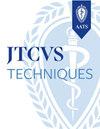Early outcomes of robotic management of aberrant subclavian artery
IF 1.9
Q3 CARDIAC & CARDIOVASCULAR SYSTEMS
引用次数: 0
Abstract
Background
Aberrant subclavian artery (ASA), though rare, can cause dysphagia lusoria and significantly affect quality of life. Conventional treatment involves open ligation and division of ASA, but a robotic approach is becoming more popular. This study assessed outcomes in patients undergoing robotic ASA division.
Methods
We retrospectively reviewed 9 patients with dysphagia who underwent robotic division of ASA between 2021 and 2025. Our standard approach is one-stage robotic ligation and division of the ASA, followed by open subclavian-to-carotid transposition (SCT). Patients undergo continued surveillance for potential thoracic endovascular aortic repair (TEVAR) in the event that Kommerell diverticulum (KD) expands. Patient demographics, presentations, aberrant anatomy, operative details, and outcomes were reviewed.
Results
The study cohort had a mean age of 49 years and mean body mass index of 30.5 kg/m2. The main presenting symptoms were dysphagia and dyspnea. An aberrant left subclavian artery with right-sided arch was seen in 5 patients; an aberrant right subclavian artery, in 4. Seven patients had KD. Eight patients underwent concurrent SCT; 1 patient had prior TEVAR and carotid-subclavian bypass for large descending thoracic and Kommerell aneurysms. The mean operative time was 169 minutes, and the mean hospital stay was 2 days. There was no postoperative stroke, bleeding, pneumothorax, chyle leak, or mortality; 1 patient experienced transient Horner syndrome. Five patients reported significant improvement in dysphagia, 1 reported moderate improvement, 1 reported mild improvement, 1 reported no change, and 1 was lost to follow-up.
Conclusions
This one-stage hybrid approach—robotic ASA division with open SCT—is safe, with no reported postoperative stroke or mortality, and offers excellent patient satisfaction. It provides a minimally invasive alternative for treating dysphagia lusoria.
机器人治疗锁骨下动脉异常的早期结果
背景:异常锁骨下动脉(ASA)虽然罕见,但可引起吞咽困难并显著影响生活质量。传统的治疗包括开放结扎和ASA分离,但机器人方法正变得越来越流行。这项研究评估了接受机器人ASA分割的患者的结果。方法回顾性分析了2021年至2025年期间9例吞咽困难患者接受ASA机器人分割。我们的标准入路是一期机器人结扎和切开ASA,然后进行开放式锁骨下至颈动脉转位(SCT)。在Kommerell憩室(KD)扩张的情况下,患者需要持续监测潜在的胸腔血管内主动脉修复(TEVAR)。回顾了患者的人口统计、表现、异常解剖、手术细节和结果。结果研究队列平均年龄49岁,平均体重指数30.5 kg/m2。主要表现为吞咽困难和呼吸困难。5例患者出现左锁骨下动脉异常伴右侧弓;右锁骨下动脉异常,第4组。7例患者有KD。8例患者同时行SCT;1例患者既往有TEVAR和颈动脉-锁骨下搭桥治疗大胸降动脉瘤和Kommerell动脉瘤。平均手术时间169分钟,平均住院时间2天。术后无中风、出血、气胸、乳糜漏或死亡;1例患者出现短暂性霍纳综合征。5例患者吞咽困难明显改善,1例中度改善,1例轻度改善,1例无变化,1例失访。结论:这种单阶段混合方法-机器人ASA分割与开放式sct是安全的,无术后卒中或死亡率的报道,并提供了极好的患者满意度。它为治疗吞咽困难提供了一种微创的选择。
本文章由计算机程序翻译,如有差异,请以英文原文为准。
求助全文
约1分钟内获得全文
求助全文

 求助内容:
求助内容: 应助结果提醒方式:
应助结果提醒方式:


